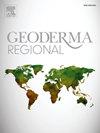用于奥地利土壤测绘应用的新水力渗透功能
IF 3.1
2区 农林科学
Q2 SOIL SCIENCE
引用次数: 0
摘要
有关土壤水文特征的知识对于土壤水动态建模、土壤制图或土木工程应用至关重要。直接测量土壤水力特性(SHPs)既费时又昂贵。因此,通常通过使用水力传递函数(PTFs)从易于测量的参数中估算出土壤水力特性。从单一流域到大陆应用等不同尺度,已开发出大量 PTF。全球 PTF 涵盖更广泛的环境条件,而区域 PTF 则是为具有独特土壤类型和地貌的特定地区而设计的。我们的主要假设是,应用代表最先进方法的机器学习(ML)方法,并结合以区域为重点的数据库,将为国家土壤制图应用提供最合适的土壤转移函数。我们使用来自 520 个农业地点约 2300 个样本的数据库开发了点 PTF。数据集涵盖了广泛的地貌和土壤类型。利用 PTF 预测了土壤田间容重(pF = 1.8 时的Θ60 和 pF = 2.5 时的Θ330)、永久枯萎点(Θ15000)和饱和导水性(Ks)。模型开发采用了随机森林(RF)方法,预测质量则采用了量子回归方法。新的 PTF 在 Ks 和 Θ15000 之间的 R2 分别为 0.56 和 0.85,并与已有的 PTF 进行了比较。随后,我们将新生成的 PTF 应用于奥地利土壤调查的官方土壤数据,以预测奥地利农业地区的水文土壤信息。10 % 和 90 % 四分位数之间的四分位数范围被可视化,以识别具有不同预测质量的区域。这将有助于未来的采样活动。对于数据集中代表性不足的主要土壤区域,不确定性较高。这包括粘土或沙土含量较高的土壤,通常出现在奥地利北部高山山麓的谷底或波希米亚山丘。对于有大量可用样本的地区,预测结果很有希望。根据这些结果,可以有效地规划进一步采样,以改进今后的工作。此外,这项研究还指明了前进的道路,强调在区域范围内评估土壤功能,为进一步建模提供重要信息,并允许调整适当的土地管理方法。本文章由计算机程序翻译,如有差异,请以英文原文为准。
New hydro-pedotransfer functions for Austrian soil mapping applications
Knowledge about the hydrological characteristics of soils is essential for modeling soil water dynamics, soil mapping, or civil engineering applications. Directly measuring soil hydraulic properties (SHPs) is time-consuming and expensive. Therefore, they are usually estimated from easily measurable parameters with pedotransfer functions (PTFs). Numerous PTFs have been developed for different scales, from a single watershed to continental applications. Global PTFs cover a broader spectrum of environmental conditions, whereas regional PTFs are designed for specific areas with distinctive soil types and landscapes. Our main hypothesis was that applying machine learning (ML) approaches representing state-of-the-art methodology, combined with a regionally focused database, would result in the most appropriate pedotransfer functions for national soil mapping applications. We developed point PTFs using a database of about 2300 samples from 520 agricultural sites. The data set encompassed a wide range of landscapes and soil types. The PTFs were utilized to predict soil field capacity (Θ60 at pF = 1.8 and Θ330 at pF = 2.5), permanent wilting point (Θ15000), and saturated hydraulic conductivity (Ks). The random forest (RF) method was employed for model development, while quantile regression was used to assess the prediction quality. The new PTFs obtained an R2 between 0.56 for Ks and 0.85 for Θ15000 and were compared with established PTFs. Subsequently, we applied the newly generated PTF to official soil data from the Austrian soil survey to predict hydrological soil information for agricultural areas in Austria. The interquartile range between the 10 % - and the 90 % - quantile was visualized to identify regions with different prediction qualities. This will be helpful for future sampling campaigns. High uncertainties were particularly identified for areas where soils dominate that are underrepresented in the data set. This includes soils with a high clay or sand content, typically found at valley bottoms of the alpine foothills or the Bohemian massif in the North of Austria. For areas with a large number of available samples, the prediction showed promising results. Further sampling for future improvements may be planned efficiently based on these results. Moreover, this research sheds light on a path forward, emphasizing assessing soil functionality on a regional scale, providing crucial information for further modeling, and allowing an adjusted and appropriate land management approach.
求助全文
通过发布文献求助,成功后即可免费获取论文全文。
去求助
来源期刊

Geoderma Regional
Agricultural and Biological Sciences-Soil Science
CiteScore
6.10
自引率
7.30%
发文量
122
审稿时长
76 days
期刊介绍:
Global issues require studies and solutions on national and regional levels. Geoderma Regional focuses on studies that increase understanding and advance our scientific knowledge of soils in all regions of the world. The journal embraces every aspect of soil science and welcomes reviews of regional progress.
 求助内容:
求助内容: 应助结果提醒方式:
应助结果提醒方式:


